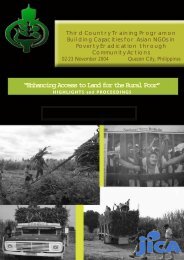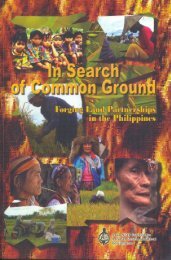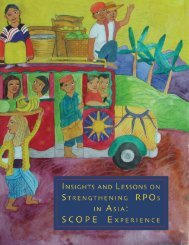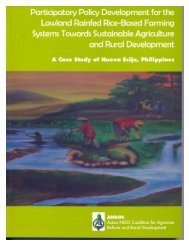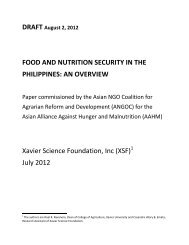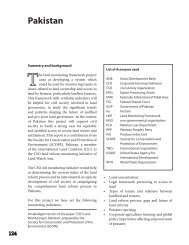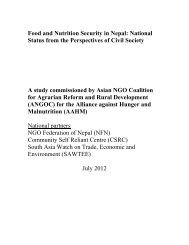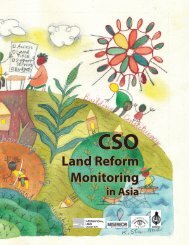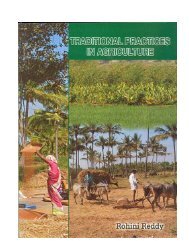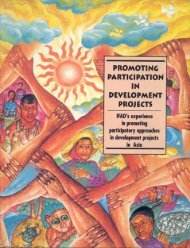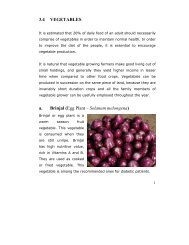Securing the Right to Land FULL - ANGOC
Securing the Right to Land FULL - ANGOC
Securing the Right to Land FULL - ANGOC
Create successful ePaper yourself
Turn your PDF publications into a flip-book with our unique Google optimized e-Paper software.
sured in terms of kilo calories [K.cal.]). Among <strong>the</strong> landless, <strong>the</strong><br />
daily per capita intake is 2,194 K.cal., which is only slightly<br />
higher than <strong>the</strong> 2,122 per capita food intake of persons living<br />
on <strong>the</strong> “absolute poverty line.”<br />
<strong>Land</strong>less households also spend almost 2.3 times less on health<br />
care than large landowners. When it comes <strong>to</strong> education, landless<br />
households spend 4.7 times less than <strong>the</strong> land rich. As a<br />
result, landownership is a determinant of literacy. <strong>Land</strong>less<br />
households are 1.6 times less likely <strong>to</strong> be literate than land-rich<br />
households. Both <strong>the</strong> overall literacy and adult literacy rates<br />
improve with increases in landownership. More importantly, <strong>the</strong><br />
gender-divide in literacy is pronounced when correlations with<br />
landownership status are made; only 37% of landless females<br />
are literate, compared <strong>to</strong> 53.2% of landless males. Moreover,<br />
<strong>the</strong> literacy gap between <strong>the</strong> landless and <strong>the</strong> land rich is<br />
higher among females (36.9%) than it is for males (24.8%).<br />
Issues Affecting Access <strong>to</strong> <strong>Land</strong><br />
Access <strong>to</strong> and Distribution of Khas <strong>Land</strong><br />
Agricultural “khas” (government owned) land is a core issue in<br />
discussions of access of <strong>the</strong> poor <strong>to</strong> land in Bangladesh. Agricultural<br />
khas land covers some 321,323 hectares. Of this,<br />
139,691 hectares, or 43.47% of <strong>the</strong> <strong>to</strong>tal agricultural khas<br />
land, has reportedly been distributed <strong>to</strong> landless households. In<br />
1997, <strong>the</strong> government instituted a policy for distributing khas<br />
land <strong>to</strong> landless peasants. “<strong>Land</strong>less peasants” were defined <strong>to</strong><br />
include landless families with or without homestead and are<br />
dependent on agriculture for <strong>the</strong>ir livelihood. The policy also<br />
prioritized certain groups, such as <strong>the</strong> families of freedom fighters,<br />
families that lost <strong>the</strong>ir land <strong>to</strong> erosion, divorced women<br />
with adult sons, landless families without homestead, and families<br />
whose lands were expropriated by <strong>the</strong> government. However,<br />
a study conducted in 2001 reported that while 82.8% of<br />
khas recipients fit in<strong>to</strong> <strong>the</strong> above-mentioned categories, as<br />
much as 17.2% of khas recipients do not even own close <strong>to</strong> a<br />
quarter of a hectare of land.<br />
Khas recipients are supposed <strong>to</strong> pay government a fee of 1taka<br />
(US$0.01, in 2008 prices) per acre of khas land received. In<br />
practice, however, khas land recipients have <strong>to</strong> fork out bribes<br />
for as much as US$105-150 (in 2008 prices) per acre. Bribes<br />
are exacted by <strong>the</strong> assistant land officer, <strong>the</strong> chair of <strong>the</strong> union<br />
THE BACKPEDALLING STOPS<br />
47<br />
parishad (<strong>the</strong> lowest tier of government), and even by minor<br />
officials at <strong>the</strong> land offices.<br />
Access <strong>to</strong> and Distribution of Nonagricultural<br />
<strong>Land</strong><br />
Before March 1995, <strong>the</strong>re were no guidelines for <strong>the</strong> manage-<br />
ment of non-agricultural land. In <strong>the</strong> absence of a regula<strong>to</strong>ry<br />
mechanism in this area, influential and well-connected persons<br />
have been able <strong>to</strong> claim ownership of non-agricultural land<br />
through a court ruling that is usually based on forged documents.<br />
In March 1995, <strong>the</strong> government issued detailed guidelines<br />
for <strong>the</strong> management and settlement of state land in urban<br />
areas. By <strong>the</strong>n, however, most of <strong>the</strong>se lands had already been<br />
awarded <strong>to</strong> <strong>the</strong> rich and powerful.<br />
Access <strong>to</strong> Government Owned Fisheries<br />
Government-owned fisheries covering 1.2 <strong>to</strong> 8 hectares,<br />
called jalmahals, are auctioned off by <strong>the</strong> Districts <strong>to</strong> fisherfolk<br />
cooperative societies. The lease, which is effective for one<br />
year, is awarded <strong>to</strong> <strong>the</strong> highest bidder. However, not all <strong>the</strong><br />
bidders are fisherfolk coops; many of <strong>the</strong>m are fronts for moneyed<br />
persons. The fisherfolk <strong>the</strong>refore end up as laborers and<br />
are merely paid wages, while <strong>the</strong> profits go <strong>to</strong> <strong>the</strong> financiers<br />
behind <strong>the</strong> operations.<br />
Absentee <strong>Land</strong>ownership<br />
Thirteen (13) percent of households own more than half (58%)<br />
of <strong>the</strong> country’s land. Many of <strong>the</strong>se households do not engage<br />
in agriculture, but live and make <strong>the</strong>ir living in urban areas,<br />
ei<strong>the</strong>r by running <strong>the</strong>ir own business or by being employed in<br />
<strong>the</strong> government or <strong>the</strong> private sec<strong>to</strong>r. This encourages rentseeking<br />
behavior.<br />
Commercialization of Agriculture and<br />
Forestry<br />
Shrimp Cultivation. 1.5 million persons are engaged in shrimp<br />
cultivation. In <strong>the</strong> early stages of this industry, shrimp culture<br />
was practiced in <strong>the</strong> household and on fallow and/or marginal<br />
land, <strong>to</strong> augment incomes from <strong>the</strong> farm. When shrimp culture<br />
became more profitable than crop farming, various coastal lands,<br />
including rice farms, mangrove areas and marshes were brought<br />
under shrimp cultivation. This has created serious environmental<br />
problems, such as deterioration of water quality, loss of vegetation,<br />
loss of biodiversity, land degradation due <strong>to</strong> increase in<br />
soil salinity, declining numbers of lives<strong>to</strong>ck and poultry, etc.<br />
ASIAN NGO COALITION FOR AGRARIAN REFORM AND RURAL DEVELOPMENT



